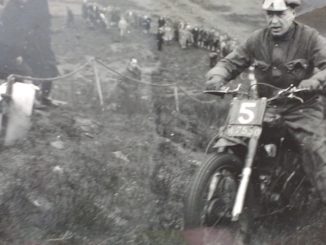
© Always Worth Saying 2022, Going Postal
If, in the mid-1960s, you visited a provincial northern cinema to watch the latest James Bond and, during a car chase through the mountains, a middle-aged couple sat nearby were heard muttering to each other politely, “Well yes, well, no, but I suppose so. Really!? Actually, been there done that, taken the photos,” you might have been sat next to my grandparents.
In the 1964 adaptation of Swiss-ophile Ian Fleming’s 1964 short story, director Guy Hamilton’s adaptation sees Odd-Job driving Auric Goldfinger in his gold-plated Rolls Royce past the Rhone Glacier and Belvedere Hotel while climbing the hairpin Fouka Pass. A melodic rendition of John Barry’s Goldfinger theme accompanies, shorn of Shirley Bassey’s belted-out lyric. Passing the Hotel Galenstock, James Bond follows in the iconic DB5 with Tilly Masterson shadowing OO7 in a white ford Mustang. On the cascade of tight curves at the other side of the Fouka, the Rolls Royce stops as Goldfinger to pretends to buy fruit from a peasant family’s roadside stall.
Bond pauses on the hairpin above and leaves his car to observe. Masterson, parked on the curve above, takes a potshot at Bond disturbing the dust at his feet. As the three vehicles resume the descent Bond conceals the DB5 and after Masterson passes, pursues her and beside a railway line in the next valley uses the Aston’s optional extendable rotating tyre shredder to drive Miss Tilly into a ditch. Offering to help, the distressed would-be assassin interrupts the gentlemanly introduction of, “The name’s Bond, J…’ and insists upon a lift to the nearest garage. Bond obliges, gingerly picking a vanity case, presumably containing a dissembled girly sniper rifle, from the Mustang’s tasteless red leather backseat.
By coincidence, Bond creator Fleming died the day filming finished and, in a further coincidence, exactly a decade earlier our family album’s equally implausible narrative saw my father and grandparents traverse the Furka (minus the worst of the gunfire and tyre-shredding) in a Ford Prefect.
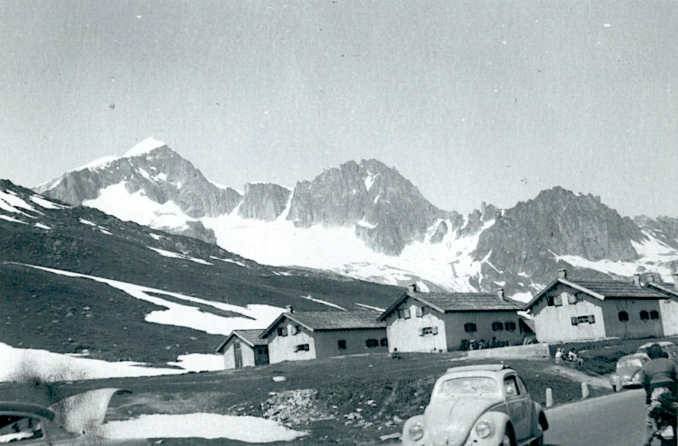
© Always Worth Saying 2022, Going Postal
At the top of the Furkapass we see the Hotel Furkablick. The chalets are still there as is the hotel which lies to the right and can be viewed via this link.
The hotel consists of two buildings. The original ten-room chalet was built in 1893. A cube of twenty-seven more rooms was added a decade later. Open only during the summer months to begin with, after the war the hotel was left completely neglected which allowed for a tasteful retro restoration decades later. Between 1983 and 1996, proprietor, gallery owner and publisher Marc Hosteller invited many famous artists to stay. Puffins will be familiar with Panamarenko, Rem Koolhaas, Jenny Holzer, Ulay, Guillaume Bijl, Richard Long, Stanley Brouwn, Filip Francis, Mario Merz, Günther Förg, Per Kirkeby, Claude Rutault, Ian Hamilton-Finlay, Lawrence Weiner and Gretchen Faust.
Not to mention household names such as François Morellet, Hamish Fulton, John Armleder, Max Bill, Rémy Zaugg, Michel Ritter, Olivier Mosset, Mark Luyten, Isi Fiszman, René Zäch, Ria Pacquée, Glen Baxter, Jacques Hainard, Luc Deleu and Roman Signer.
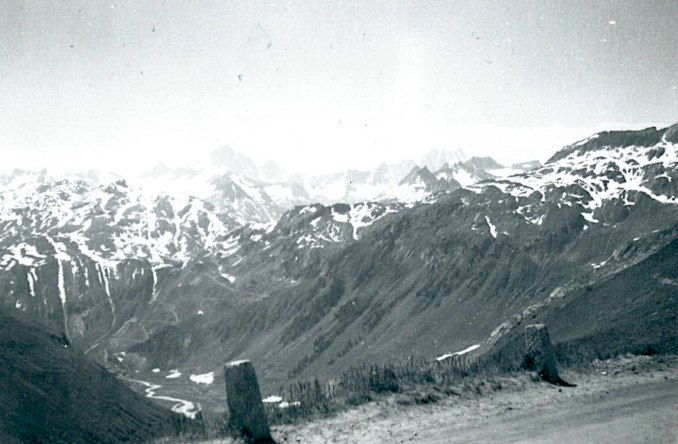
© Always Worth Saying 2022, Going Postal
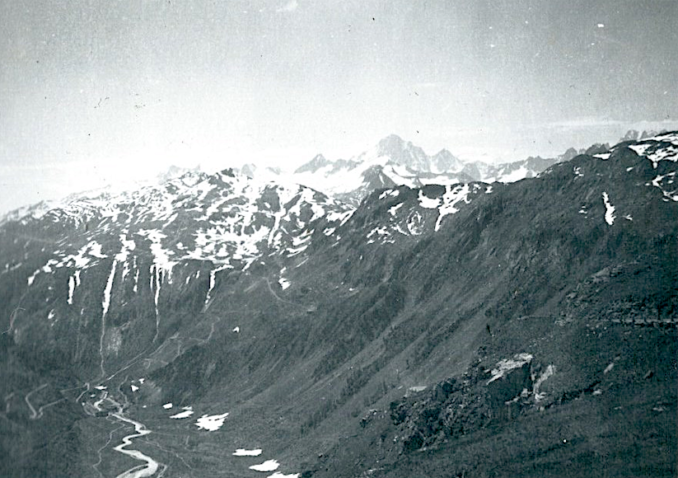
© Always Worth Saying 2022, Going Postal
Pictured near the top of the western end of the pass, the concrete posts have survived. The exact same spot is difficult to locate as Street View has thrown a wobbler and was unable to follow in the burnt tyre tracks of the gold-plated Rolls Royce, DB5, Mustang and Ford Prefect. Down the valley of the Rhone and to the left can be seen another hairpin pass, Grimsel. The River Rhone runs through the dip and the road, the Furkastrasse, is visible to the left making a straight line decent towards the Rhone Glacier Hotel. Confusingly the hotel next to the actual glacier is called the Belvedere with the hotel in the valley being the Glacier.
Some modern-day still photographs are available via Street View, here and on the next curve here. Note that the road is now wider and that sections have been put up on stilts to ease the grade. Some serious waterfalls can be seen in the distance.
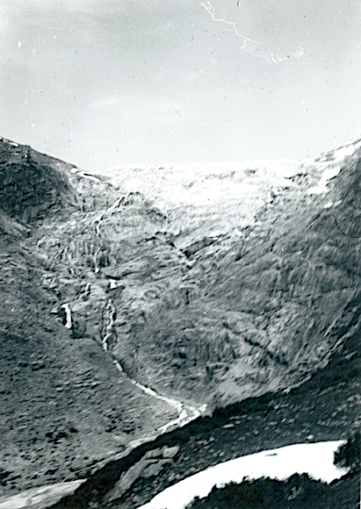
© Always Worth Saying 2022, Going Postal
According to wiki;
The Rhône Glacier is the largest glacier in the Urner Alps. It lies on the south side of the range at the source of the Rhône. The Undri Triftlimi (3,081 m) connects it to the Trift Glacier. The glacier is located on the northernmost part of the canton of Valais, between the Grimsel Pass and the Furka Pass and is part of the Oberwald municipality. The Dammastock (3,630 m) is the highest summit above the glacier.
Wikipedia also obsesses over the glacier’s retreat. As the road makes it easily accessible, its evolution has been closely observed over a long period of time. According to wiki, the glacier has retreated about 1,300m during the last 120 years. Judging by the distinctive markings on the nearby rock face and with reference to recent aerial photography, this reviewer of old photographs would estimate the retreat has covered about 300m in the 68 years since my grandparents’ and father’s visit.
Given seven kilometres of moving ice lie between the present glacial face to its origin at the ridge which separates the cantons of Valais and Berne, at the 1954-2022 rate of retreat Puffins have until the year 2598 to visit before it’s gone. Having said that, given the 2010s were colder than the 2000s and as I type it is bigly freezy cold, Puffins may have to be quicker off the mark if they want to see the hotel before it’s crushed by a newly advancing glacier.
Although wiki and others keenly tell of shrinking ice, they are less enthusiastic about informing us of glaciers that are expanding. Located halfway between Vancouver and Anchorage, Taku Glacier has advanced 5km since 1933. A big beast which leads from Alaska’s Juneau Icefield to sea level at Taku Inlet, the face is four and a half miles long, compared to Rhone’s 400 yards.
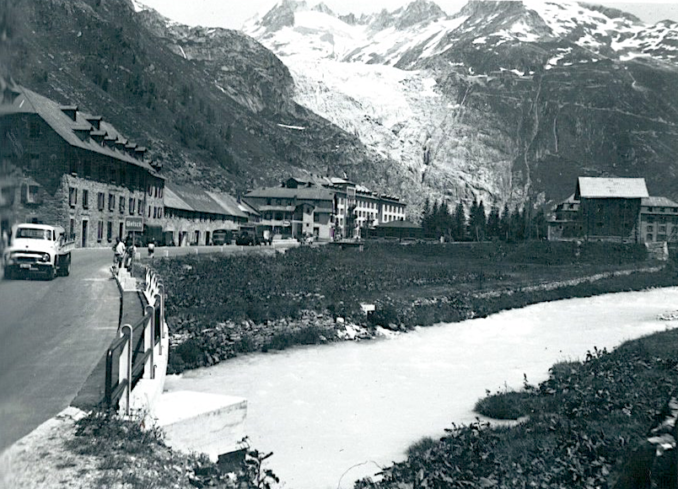
© Always Worth Saying 2022, Going Postal
Just before the valley takes a sharp turn south at the foot of the Grimsel Pass sits the aforementioned Grand Hotel Glacier du Rhone. Looking unwell and currently closed, we do have a poor Street View image as the Google car joins the fray taking a stream mainly of its own roof. Oh, for the days of Panavision and Technicolor or even Box Brownies and Velex.
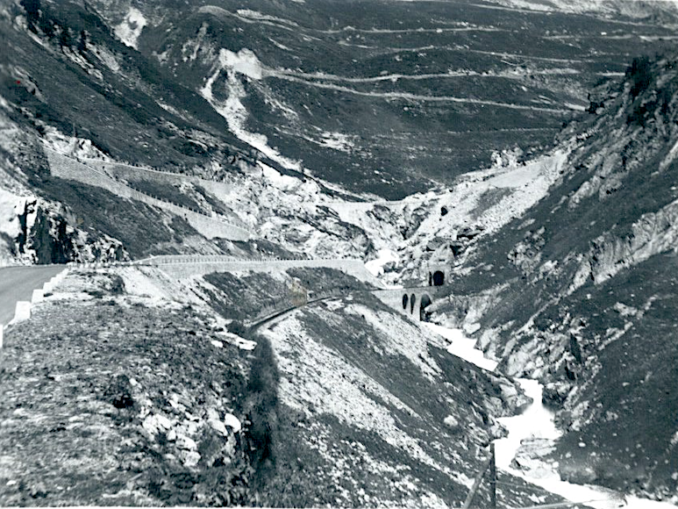
© Always Worth Saying 2022, Going Postal
Another sharp hairpin and sight of the Grimsel Pass, a railway line, tunnel and the infant Rhone makes the above location easy to find. The railway tunnel is short and emerges before the Glacier Hotel – which has its own station, Gletsch, a German word for glacier. From there, the permanent way follows the road along the Rhone and then the Rhone’s Muttbach tributary. Following parallel to the straight Furkastrasse, the rails diverge as the road addresses the pass and remains with the Muttbach for another 1,000 yards before entering a one-and-a-quarter-mile tunnel which takes it under the Furkapass to emerge on the other side of the ridge at Furka railway station.
Now well below the road, the line avoids a long, slow hillside descent and instead hugs the banks of the river Reuss, allowing the flowing water’s thousands of years of erosion to ease the gradient towards Realp. It is after Realp that a long stretch of road beside the railway line allowed Bond to shred Miss Masterson’s tyres while overtaking. Realp itself appears earlier in the Goldfinger scene, out of sequence, before not after the Belevedere Hotel.
Away from the old photographs, a new tunnel was completed in 1982 which emerges just before Relph and avoids the steeper climb and higher altitudes of the old route which had to be ‘summer only’ because of winter snows. The old rails remain and are a preserved rack and pinion line for tourists called the Furka Cogwheel Steam Railway. Six stations are spread along an 18km route which rises to an altitude of 7,078ft.
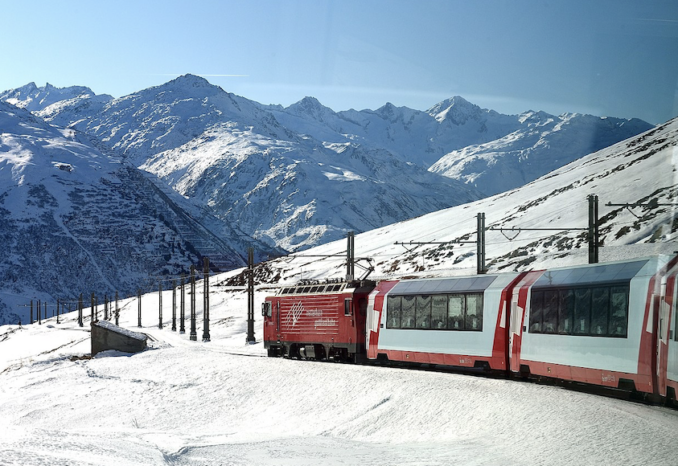
Glacier Express train east of Andermatt,
Tim Adams – Licence CC BY-SA 3.0
The line was originally completed in 1925 and is the route of the world-famous Glacier Express, an 8-hour, 181-mile-long service that runs daily from Zermatt to St Moritz. Wanderlust Puffins of a certain age will be familiar with shrugging nonagenarian Pakistani station masters ignorant of the whereabouts of the Kyber Mail and handwritten timetables available from the duck embryo stall at Athens Peloponnese. However, those clever people known as the Swiss have managed to put their entire railway timetable and map onto one easy-to-grasp graphic. Not quite sure I understand it, but cleverer Puffins than I can have a deco here.
Suffice it to say, the Upper Rhone Valley route is a single-track line with trains from opposite directions passing at Munster at 25 minutes past the hour. As the line continues southwest it reaches Brig at the other end of the Simplon Tunnel from Italy and becomes part of the much more intense Swiss national and international railway system.
© Always Worth Saying 2022


